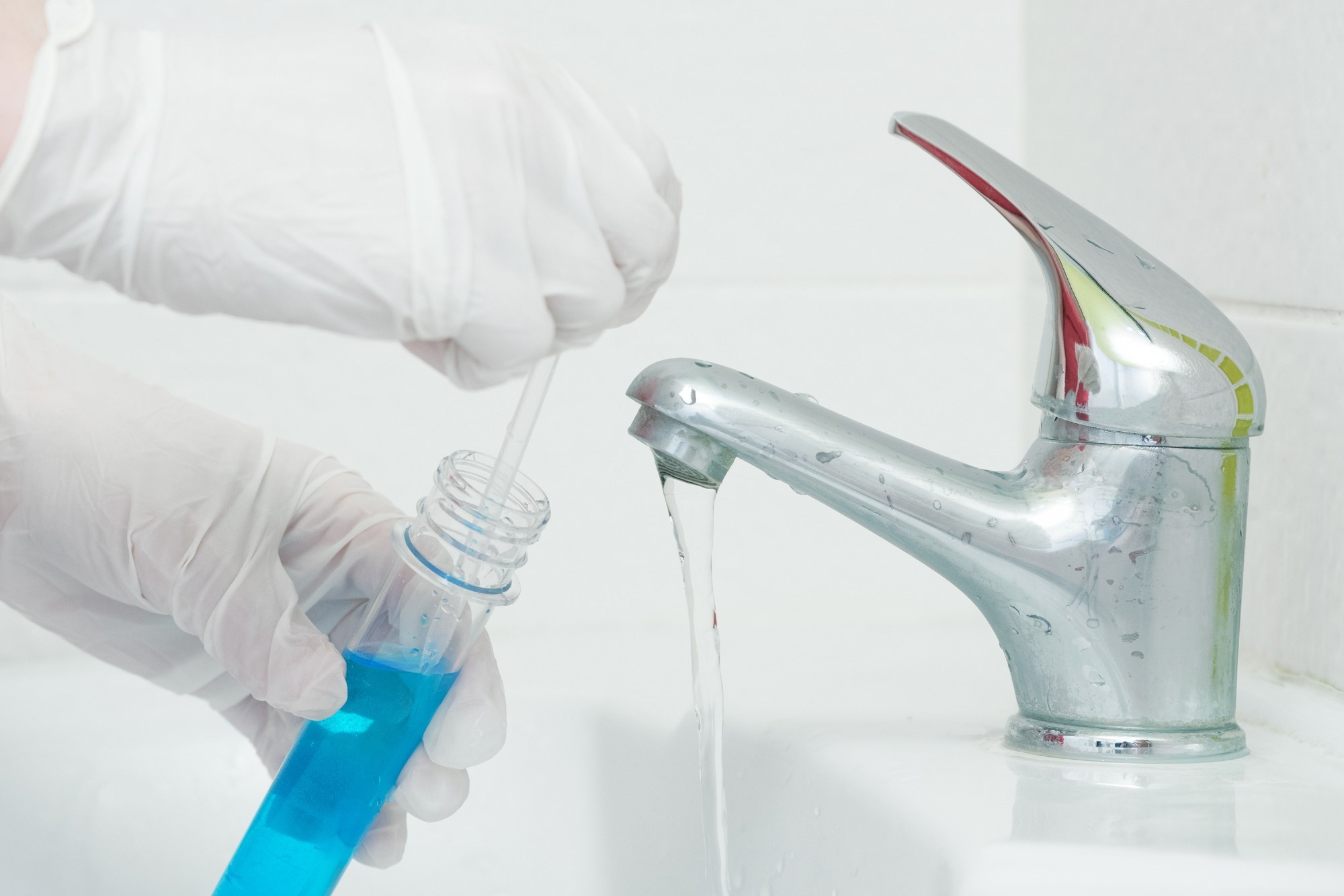In a recent article published in Results in Surfaces and Interfaces, researchers introduced a novel method for the rapid and cost-effective detection of arsenic in drinking water through surface-enhanced Raman spectroscopy (SERS). This technique amplifies weak Raman signals from molecules by utilizing metal nanoparticles.

Image Credit: Happy_Nati/Shutterstock.com
Background
Arsenic contamination in drinking water poses serious health risks, including cancer and cardiovascular diseases. The World Health Organization (WHO) limits arsenic to 10 parts per billion (ppb) in drinking water, necessitating sensitive, rapid, and cost-effective detection methods.
Traditional detection methods like inductively coupled plasma mass spectrometry, atomic absorption spectroscopy, and high-performance liquid chromatography are sensitive but require expensive, complex equipment and are not field-friendly.
In contrast, field-deployable techniques such as colorimetric assays, laser-induced breakdown spectroscopy, and anodic stripping voltammetry suffer from low sensitivity and selectivity.
SERS offers a promising alternative due to its sensitivity, rapidity, non-destructive nature, and selectivity. It relies on localized surface plasmon resonance, which amplifies Raman signals from target molecules using nanostructures or rough metal surfaces.
Recent advancements in SERS have enabled quantitative detection of arsenic down to 1 ppb. However, these techniques remain expensive and time-consuming.
About the Research
In this paper, the authors developed a sample-preparation-free method for the quantitative detection of arsenic in drinking water using SERS. This method involves fabricating SERS substrates using silver nanoparticles (AgNPs) for arsenic detection.
The primary focus was optimizing the concentration of AgNPs through centrifugation and eliminating interference from residual trisodium citrate (TSC), a stabilizing agent used in AgNP synthesis. The fabrication process included three main steps: synthesizing AgNPs, optimizing centrifugation, and fabricating SERS substrates.
Initially, AgNPs were synthesized using the Lee and Meisel chemical reduction method, which reduces silver nitrate (AgNO3) with TSC in a boiling water solution. The researchers then optimized the centrifugation parameters, including speed and duration, to maximize AgNP concentration while minimizing TSC interference.
They found that centrifugation at 3000 rpm for 20 minutes, followed by two consecutive cycles, resulted in the highest AgNP concentration and effective TSC removal.
Finally, the concentrated AgNPs were dropped-casted onto hydrophobic silicon substrates treated with hydrofluoric acid (HF) to enhance hydrophobicity. The drying process induced a coffee-ring effect, causing pronounced spatial variation in nanoparticle concentration. This ranged from 50 ppb to 200 ppb in tap water, with significantly higher densities observed in the peripheral ring regions compared to the central areas of the substrate.
Research Findings
The results showed that the peripheral area of the SERS substrates exhibited significantly greater Raman enhancement and improved reproducibility compared to the central regions due to the higher and more uniform density of AgNPs.
Eliminating residual TSC from the AgNPs through consecutive centrifugation cycles further enhanced the detection sensitivity for arsenic. The optimized SERS method showed a detection limit for arsenic of 50 ppb, which meets the permissible limit set by the WHO.
Additionally, the authors demonstrated a linear relationship between the Raman intensity of the arsenic peak and its concentration, with a coefficient of determination of 0.9563, indicating a good fit and linearity of the calibration curve.
Applications
The developed SERS substrates represent a breakthrough in arsenic detection technology. Offering a practical and cost-effective solution for identifying arsenic in drinking water, they provide a viable alternative to conventional detection methods. This advancement empowers researchers to assess arsenic levels swiftly and accurately in water samples.
This technique also has significant implications for public health protection. By enabling rapid and sensitive analysis, it facilitates early detection of arsenic contamination in water sources, allowing authorities to intervene promptly and mitigate potential health risks. This proactive approach can prevent prolonged exposure to harmful levels of arsenic, safeguarding the well-being of communities relying on these water sources.
Additionally, this method can streamline the detection process, making it accessible to a broader range of stakeholders, including field researchers, environmental agencies, and water treatment facilities. This accessibility can enhance the efficiency of monitoring efforts, ensuring timely identification of contaminated water sources and facilitating targeted remediation measures.
Notably, the SERS substrates excel in detecting arsenic concentrations exceeding 50 ppb, underscoring their utility in identifying severe contamination. However, their versatility extends beyond high-concentration scenarios, as they can also be employed for more precise analysis of samples with lower arsenic levels.
In such cases, advanced analytical techniques can complement the initial screening provided by SERS, enabling comprehensive assessment and accurate determination of arsenic concentrations, even at trace levels.
Conclusion
In summary, the SERS-based technique effectively detected arsenic in drinking water. The simplicity of the fabrication process and the use of cost-effective materials make this method a promising solution for initial field analyses.
The authors acknowledged limitations and challenges, such as the need for further research and validation to explore the usability of these SERS substrates in real-world examples and address implementation challenges.
They recognized that while the method was suitable for initial field assays, more precise and sensitive analysis of samples with arsenic concentrations below 50 ppb would require advanced secondary methods. They also suggested exploring the potential of these SERS substrates for detecting other contaminants in drinking water.
Journal Reference
Noorbakhsh, PS., et al. (2024). Rapid and cost-effective quantitative analysis of arsenic in drinking water using surface-enhanced Raman spectroscopy. Results in Surfaces and Interfaces. doi.org/10.1016/j.rsurfi.2024.100236
Disclaimer: The views expressed here are those of the author expressed in their private capacity and do not necessarily represent the views of AZoM.com Limited T/A AZoNetwork the owner and operator of this website. This disclaimer forms part of the Terms and conditions of use of this website.